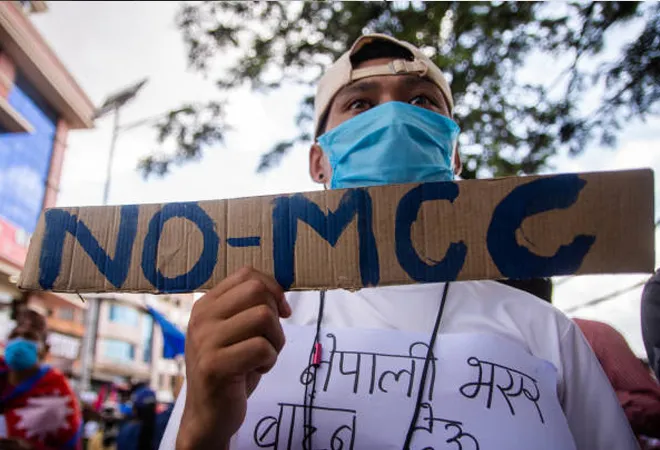
On the night of 27 February, the House of Representatives (HoR), the lower House of Nepalese Parliament ratified the Millennium Challenge Corporation (MCC) with over two-thirds majority, paving the way for receiving the grants amounting to US$500 million from the American government for the construction of electricity transmission line and for repairing and maintenance of roads in Nepal in the next
five years. The MCC was
tabled in the Nepalese Parliament in July 2019, but it could not be passed for a long time because of the differences amongst the political leaders on this issue. But on 27 February, almost all the political parties—be it the government or opposition, including the Nepali Congress, the Loktantrik Samajbadi Party (LSP), Janata Samajbadi Party (JSP), the Communist Party of Nepal–Maoist Centre (CPN-MC), the Communist Party of Nepal–United Socialist (CPN-US), and the Communist Party of Nepal -Unified Marxist-Leninist (CPN-UML) voted in favour of MCC.
The MCC was ratified by the Parliament at a time when protests against the MCC was quite visible both within and outside the parliament. After witnessing the opposition piled against the MCC, it was difficult to fathom even until the last hour if the MCC would be passed at all. Amidst such a situation, it appeared as a miracle when the MCC was successfully passed and that too with over two-thirds majority.
The MCC was ratified by the Parliament at a time when protests against the MCC was quite visible both within and outside the parliament.
What worked in favour of the MCC in the last hour was the ‘12-point Interpretive Declaration’ that was also passed by the Parliament at the same time when the MCC was ratified. This declaration helped mollify those who were protesting against the MCC as it ensured that the MCC was neither a part of the US Asia-Pacific strategy nor was it above the
Nepalese Constitution.
Yet, experts believe that the 12-point interpretive declaration is not meaningful as the MCC does not recognise anything that it does not mention. However, later on, the American ambassador to Nepal, Randy Berry, stated that the 12-point interpretive declaration was nothing but what the
Americans already have been explaining about the MCC.
Background
The MCC is the foreign assistance wing of the USA that aims at supporting the developing countries in their fight against poverty. Intending to reduce poverty through growth, Nepal and the MCC signed an agreement on 14
September 2017, in Washington DC for the construction of
300 kilometres of 400KV transmission lines from the Lapsiphedi-Galchhi-Damauli-Sunawal corridor, apart from repairing and maintaining
300-kilometre roads in different locations of the country. Accordingly, the MCC agreed to provide grant assistance worth US$500 to Nepal. Besides, the Nepalese government also committed to allocate an additional US$130 million for this project. Thus, the total cost of the MCC project stood at US$ 630 million. This has been the largest foreign grant assistance that Nepal is likely to receive.
Before the MCC was ratified, certain elements aided in spreading misinformation and false rumours against the MCC. It was said that the ratification of MCC meant pushing Nepal towards the US Asia-Pacific strategy. The MCC was also criticised on the ground that it superseded the Nepalese Constitution, and was targeted against the Belt and Road Initiative (BRI) of China.To make matters worse, protests took place almost every day on the streets of Kathmandu against the MCC.
The total cost of the MCC project stood at US$ 630 million. This has been the largest foreign grant assistance that Nepal is likely to receive.
To dispel some of these doubts concerning MCC, several high-level delegations of the American government visited Nepal and interacted with different groups of people in their bid to convince the Nepalese that the MCC was merely a gift from the American people to the Nepalese and there was hardly any string attached to it. It was revealed that each government and political party when in power in Nepal expressed their desire to receive the American grant assistance.
To expose the elements that opposed the MCC, the secret letter jointly written by Maoist leader Pushpa Kamal Dahal and Prime Minister Sher Bahadur Deuba to MCC headquarters was leaked to the press in which the duo had asked the MCC to give them four-five months till 28 February to create a congenial environment for the ratification of the MCC through the Parliament. With the publication of this letter, the Maoist leader Dahal, who happened to be the most vocal critic of MCC, found himself in an embarrassing situation as he was criticised both by the public and by his party workers.
Furthermore, the American government also threatened that it would
‘review’ its relations with Nepal if the MCC was not ratified by the Nepalese parliament by 28 February. Such a warning from the American government created uneasiness amongstthe Nepalese politicians. Reviewing relations with Nepal meant a massive
cut in aid and assistance, not only from the US but also from the European Union and the multilateral institutions such as the World Bank and the Asian Development Bank (ADB) which are highly influenced by the US.
The Maoist leader Dahal, who happened to be the most vocal critic of MCC, found himself in an embarrassing situation as he was criticised both by the public and by his party workers.
At times, the US authorities charged that China was creating hurdles in the ratification of MCC. The Chinese diplomats, on the other hand, charged that the Americans adopted coercive diplomacy to push the Nepalese to ratify the MCC. The spokesperson of China’s Foreign Ministry also asked if the MCC was a
‘Gift’ or ‘Pandora’s Box’?
Conclusion
It was with great difficulty that the MCC was passed by the Nepalese Parliament, for which the credit largely goes to Prime Minister Sher Bahadur Deuba and his government as they worked tirelessly until the eleventh hour. Since the MCC is now passed by the Parliament, the life of the coalition government that was at stake has been saved. But this has made the government more accountable to use the huge funds under the MCC judiciously for the development of the energy and transport sector of the country. One of the major challenges before the Nepalese government is that it has not streamlined its capacity to spend. In such a situation, it would be difficult to achieve the desired outcome from the American grant assistance. So, all possible efforts need to be made by the government and the concerned agencies to complete the MCC projects in time and thereby, promote the export of surplus power to India. This would not only generate income and employment opportunities but would also accelerate the rate of economic growth of the country.
The views expressed above belong to the author(s). ORF research and analyses now available on Telegram! Click here to access our curated content — blogs, longforms and interviews.



 On the night of 27 February, the House of Representatives (HoR), the lower House of Nepalese Parliament ratified the Millennium Challenge Corporation (MCC) with over two-thirds majority, paving the way for receiving the grants amounting to US$500 million from the American government for the construction of electricity transmission line and for repairing and maintenance of roads in Nepal in the next
On the night of 27 February, the House of Representatives (HoR), the lower House of Nepalese Parliament ratified the Millennium Challenge Corporation (MCC) with over two-thirds majority, paving the way for receiving the grants amounting to US$500 million from the American government for the construction of electricity transmission line and for repairing and maintenance of roads in Nepal in the next  PREV
PREV


